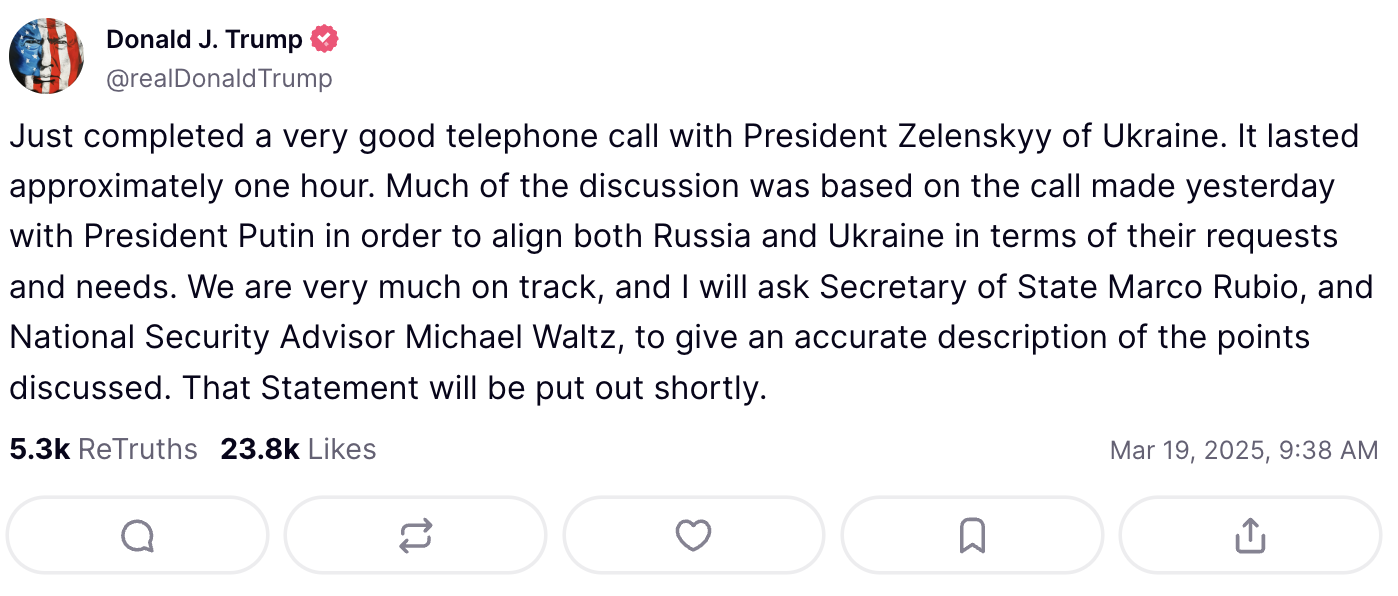Powell Holds the Line
What has President Trump said this week?
〰️
What has President Trump said this week? 〰️
1.Conflict of Interest (Rates)
Last month, President Trump took to Truth Social, declaring that “Interest Rates should be lowered” as part of his MAGA economic plan. While Trump has no direct authority over the Federal Reserve, his policies—including tariff hikes, mass deportations, and sweeping budget cuts through the Department of Government Efficiency (DOGE)—are increasing pressure on the Fed to respond to shifting economic conditions.
In August 2024, Federal Reserve Chair Jerome Powell stood at the podium at the Jackson Hole conference, delivering an optimistic outlook. He announced the Fed’s plan to begin cutting interest rates, signaling the end of its years-long fight against pandemic-era inflation. “The time has come,” Powell told the audience, pointing to a steady decline in price increases. But just months later, that confidence has faded. Trump’s unpredictable trade policies have rattled markets, fueled inflation fears, and heightened recession risks. The Fed warns of rising unemployment, slower GDP growth, and increased economic uncertainty (NBC, 2025).
Today, Wednesday, March 19th, the Fed met to assess whether a change in reference interest rates was warranted. The Fed kept rates unchanged, with Powell blaming Trump’s tariffs for a “good part” of recent price increases. With Trump pushing for cuts while enacting inflationary policies, the Fed faces mounting challenges in balancing economic stability and political pressure.
2. All Eyes on a Cease-Fire in Ukraine
On Wednesday, March 19th, President Trump spoke with Ukrainian President Volodymyr Zelenskyy to discuss a recent conversation between the U.S. ambassador and Russian President Vladimir Putin.
According to Trump, the call addressed both Russia’s and Ukraine’s “requests and needs” in pursuit of a ceasefire. While Putin agreed to temporarily halt attacks on Ukraine’s energy infrastructure, he refused the 30-day ceasefire Trump had pushed for. Despite this—and Russia’s near-immediate violation of the pause—Trump insists negotiations are “very much on track.”
Further talks are set for Sunday in Saudi Arabia, where discussions will center on a maritime ceasefire in the Black Sea and a broader peace agreement (Reuters, 2025).
3. Billions for Climate Still on Track—For Now
A federal judge has temporarily blocked the Environmental Protection Agency (EPA) from revoking $14 billion in climate grants awarded under the Biden administration. The EPA cited alleged fraud and mismanagement by grant recipients, but failed to provide sufficient evidence. The agency framed the move as part of the Trump administration’s broader deregulation agenda (NYT, 2025).
This decision is just one piece of a larger shift in environmental policy. Trump’s presidency has consistently prioritized deregulation over climate policy. During his first term, he withdrew the U.S. from the Paris Agreement, and on the first day of his second term, he did so again—reaffirming his administration’s opposition to global climate cooperation. These rollbacks could have serious public health consequences, as targeted regulations were projected to prevent nearly 200,000 deaths over the next 25 years by reducing pollutants and greenhouse gas emissions (The Guardian, 2025).
Now, the EPA is taking its efforts even further. Last week, the Agency announced plans to dismantle 31 environmental regulations, including a key ruling that serves as the foundation of U.S. climate policy. “By overhauling massive rules on the endangerment finding, the social cost of carbon, and similar issues, we are driving a dagger through the heart of climate-change religion and ushering in America’s Golden Age,” wrote EPA Administrator Lee Zeldin in The Wall Street Journal (WSJ, 2025). But undoing regulations is a slow and complex process, and in the case of climate rules, the agency may be creating legal challenges for itself.



